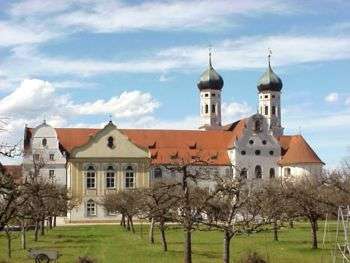Benediktbeuern
| Benediktbeuern | ||
|---|---|---|
 Benediktbeuern Abbey | ||
| ||
 Benediktbeuern Location of Benediktbeuern within Bad Tölz-Wolfratshausen district  | ||
| Coordinates: 47°43′0″N 11°24′0″E / 47.71667°N 11.40000°ECoordinates: 47°43′0″N 11°24′0″E / 47.71667°N 11.40000°E | ||
| Country | Germany | |
| State | Bavaria | |
| Admin. region | Oberbayern | |
| District | Bad Tölz-Wolfratshausen | |
| Municipal assoc. | Benediktbeuern | |
| Government | ||
| • Mayor | Georg Rauchenberger | |
| Area | ||
| • Total | 37.86 km2 (14.62 sq mi) | |
| Elevation | 640 m (2,100 ft) | |
| Population (2017-12-31)[1] | ||
| • Total | 3,621 | |
| • Density | 96/km2 (250/sq mi) | |
| Time zone | CET/CEST (UTC+1/+2) | |
| Postal codes | 83671 | |
| Dialling codes | 08857 | |
| Vehicle registration | TÖL | |
| Website | benediktbeuern.de | |
Benediktbeuern is a municipality in the district of Bad Tölz-Wolfratshausen in Bavaria, Germany, 2 kilometers, or 1.25 miles from Bichl. The village has about 3,620 residents as of 31 December 2015.
Benediktbeuern has a famous monastery, formerly belonging to the Benedictine Order, called Benediktbeuern Abbey, which was founded in about 739. Its name is well known because of the Carmina Burana manuscript found there in 1803 and subsequently set to music by Carl Orff. (Carmina Burana can be translated as "Songs of Beuern.") Since 1930 the Salesians of Don Bosco have lived in this monastery.
Johann Wolfgang von Goethe visited Benediktbeuern during his third journey to Italy in 1786.
The secular village itself - its ribbon-development clearly distinct from the abbey's edifices - was called Laingruben until 30 November 1865, when it was permitted to take the name of the monastery. Benediktbeuern has kept the structure of a traditional village near the Alps. The village can be used as a base for day trips to many places of interest, and it has become a tourist resort. Many residents of the village commute to Penzberg, Wolfratshausen/Geretsried and Munich.
Important road connections are the motorway from Munich to Garmisch-Partenkirchen and State Route 472 from east to west. From Benediktbeuern railway station trains run from Kochel to Munich in an hour, and the village has a bus connection to Bad Tölz.
References
- ↑ "Fortschreibung des Bevölkerungsstandes". Bayerisches Landesamt für Statistik und Datenverarbeitung (in German). September 2018.
External links
| Wikimedia Commons has media related to Benediktbeuern. |
- (in German) www.benediktbeuern.de Village Website
- (in German) www.kloster-benediktbeuern.de Monastery Website
